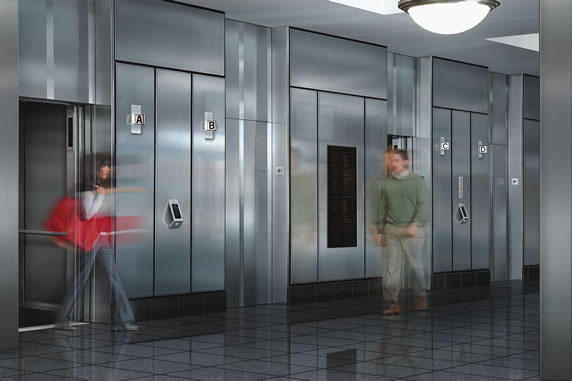
The newest destination dispatch technology features a touchscreen, a proximity sensor that operates in low-energy mode when not in use, an ambient light sensor that determines necessary brightness levels for the screen, and an even greater ability to streamline traffic flow during peak usage periods.
With urban U.S. populations growing faster than any other demographic, and UN World Urbanization Prospects reports projecting that 60 percent (4.9 billion) of the world’s population will live in cities by 2030, space in the modern American city has never been at a higher premium. As more and more people funnel into urban areas, the only place left to build is up.
But how can a building accommodate increases in population without increasing waiting times for elevators and impacting energy consumption? The answer: technology.
The Start of Destination Dispatching
Destination dispatching, first introduced in 1992, replaced traditional “up-and-down” call buttons in hallways with keypads that allow passengers to input their destination before they enter the elevator. For the first time, by prompting passengers to choose their destination before entering a car, elevators could group and sort passengers by like destinations, resulting in fewer stops, less wasted energy, and greater up-peak handling capacity. The end result of this new technology was that fewer cars could move more people.
Using Advanced Algorithms
The next generation of destination dispatch technology utilized an advanced algorithm that instantly calculated the optimal elevator arrangement based on the number and variation of calls at that exact moment. The technology also made use of RFID card readers within elevator systems, further enhancing the idea of elevator personalization. Passengers identified themselves through a personalized badge or ID card that was programmed with individual details about the passenger. Not only did these advanced systems know where a passenger needed to go based on his or her ID card, but it also knew who the passenger was and personalized the trip accordingly.
Latest Destination Dispatch Advancements
Now, with the introduction of the latest destination dispatch technology, the latest advancements are designed to provide facility managers with significant overall energy savings of up to 30 percent over conventional systems. They also offer a simple, intuitive user interface for this complex technology.
The newest destination dispatch technology helps meet environmental challenges through features like a touchscreen, a proximity sensor that operates in low-energy mode when not in use, an ambient light sensor that determines necessary brightness levels for the illuminated screen, and an even greater ability to streamline traffic flow during peak usage periods.
Because this technology learns and adapts to the specific traffic patterns of each tenant or occupant – and the building as a whole – it provides unparalleled service by helping predict user needs before they arise. These systems can account for off-peak periods that put a strain on resources. By using specialized energy control options (ECOs), which define the average acceptable passenger waiting time for a building, the system places unnecessary elevators into standby mode or, in some cases, into sleep mode when wait times fall below the specified level.
One of the most important features of this new technology, however, is that it has the ability to integrate seamlessly with any elevator system. This provides facility managers with a unique opportunity to upgrade elevator systems virtually overnight, with no service interruption.
As facility managers seek to meet the latest demands from demands, sustainability goals, and the bottom line, elevator systems will undoubtedly play a key role in the ability to provide comfortable, productive environments. Necessity truly is the mother of invention; while we may not know exactly what the future holds, we do know that destination-dispatch will lead the way.
Image courtesy of Schindler
Nicole Saloio
Nicole Saloio is manager, destination products for Schindler Elevator Corporation. She is responsible for the launch and implementation of revolutionary Schindler technologies in North America. Saloio has 20 years of experience in the elevator industry, and has served in a variety of technical, product development, and commercial positions.

